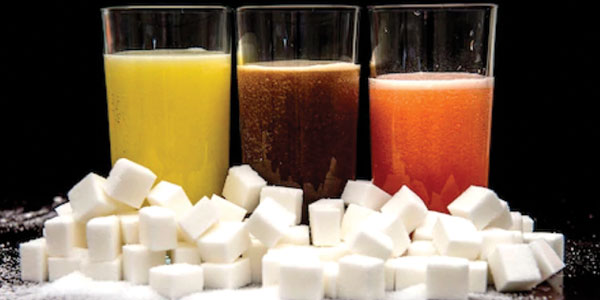
Be judicious with juice
Although soft drinks themselves are quick to get a bad rap, they’re not the entire problem. A study published this past July in the British Medical Journal found that along with sugary soft drinks, 100 percent fruit juice can also raise the risk of cancer. But in these cases, portion size may be the main problem. “A serving size of juice is four ounces, but nobody just drinks that amount,” says Farrell Allen. Instead, she says, they down an entire 20-ounce bottle, which contains a whopping 52 grams of sugar per serving.
Bottom line: If you want a small glass of OJ in the morning, that’s absolutely fine, especially if the rest of your diet is healthy, says Farrell Allen. But keep in mind more than that just provides extra sugar and calories, and since juice has little fiber, it won’t provide the full feeling that comes with eating fruit whole.
Stick to H20 — and spice it up
Water, along with low-fat or fat-free milk and unsweetened coffee and tea, are still the best ways to get your fluids, says Coates. You can replace your soft drinks with infused water: Simply drop fruit like berries, cherries or peaches into your water. (For best results, use frozen fruit, since the flavor will intensify as the fruits thaw.) If you really crave a carbonated beverage, opt for sparkling water. If you opt for a flavored version, choose a brand sweetened with natural fruit rather than regular or artificial sweeteners.
¿Tomar refrescos puede en verdad matarte? Parte 3
Ten cuidado con los jugos
Aunque los refrescos se ganan rápidamente una mala reputación, no son el único problema. Un estudio publicado el pasado julio en la revista British Medical Journal (en inglés) halló que, al igual que los refrescos de dieta, los jugos 100% de fruta también pueden aumentar el riesgo de cáncer. Pero en estos casos, el tamaño de la porción puede ser el problema principal. «El tamaño de una porción de jugo es cuatro onzas, pero nadie bebe sólo esa cantidad», explica Farrell Allen. En vez, dice, se beben una botella completa de 20 onzas que contiene unos increíbles 52 gramos de azúcar por porción.
Conclusión: si quieres un vaso pequeño de jugo de naranja en la mañana, eso está perfectamente bien, en especial si el resto de tu dieta es saludable, dice Farrell Allen. Pero no olvides que tomar más de esa cantidad sólo aporta azúcar y calorías adicionales, y como el jugo tiene poca fibra, no te hará sentir igual de satisfecho que si comieras la fruta entera.
Bebe agua… y agrégale sabor
El agua, la leche descremada o baja en grasa y el café y el té sin azúcar son las mejores maneras de hidratarte, dice Coates. Puedes reemplazar tus refrescos por agua saborizada: simplemente agrega frutas como bayas, cerezas o melocotones al agua que vas a beber. (Para obtener los mejores resultados, usa frutas congeladas, ya que el sabor se intensifica a medida que la fruta se descongela). Si tienes muchas ganas de tomarte una bebida carbonatada, elige agua con gas. Si optas por una versión con sabor, elige una marca endulzada con fruta natural en vez de edulcorantes regulares o artificiales.









